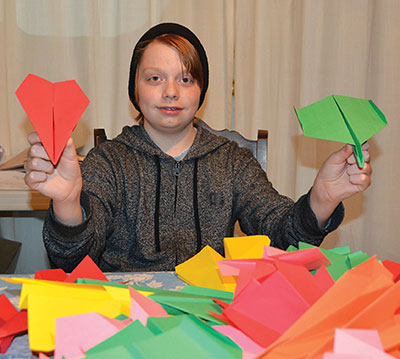
Features
Operations
Glide Path: Practising model behaviour
Picture yourself as Peter Graves, at the start of yet another episode of Mission Impossible, when his character Jim Phelps would extract that impossibly small tape recorder from under the shelf in a phone booth (you do remember phone booths, don’t you?).
July 7, 2014 By Paul Dixon
Picture yourself as Peter Graves, at the start of yet another episode of Mission Impossible, when his character Jim Phelps would extract that impossibly small tape recorder from under the shelf in a phone booth (you do remember phone booths, don’t you?).
 |
|
| Motivating, exhorting, cajoling and even begging seem to have little effect on today’s 13-year-olds. PHOTO: Paul Dixon
|
Your mission this week, Mr. Phelps, is to find the perfect airplane and let nothing stand in your way. As the tape starts to self-destruct the enormity of the task sinks in. Have you been singled out to fulfill the CF-18 replacement project? The fixed-wing SAR replacement per chance, or could it be another kick at the Maritime Helicopter project? No friend, it’s nothing quite that simple, it’s the dreaded Grade 8 Science Fair project.
I can’t speak for the rest of Canada, but in B.C., the annual Grade 8 Science Fair is part of the curriculum for every student and by default, parents, guardians and the assorted passers-by. Above all, it’s an exercise in making time stand still, in stretching a seemingly simple project over four months while making it seem like four years. Motivating, exhorting, cajoling and even begging seem to have little effect on today’s 13-year-olds (if they ever did) in an exercise that makes Sisyphus look like a clean breakaway in comparison.
OK, we finally settle on doing something to do with paper airplanes. So, what are we looking for? Is there a “best” paper airplane? Turns out it’s not quite that simple. There’s a world record for distance (226 feet and 10 inches) and another record for longest time flying (29.2 seconds), but it’s not the same airplane design. Then there’s the highest-flying paper airplane. There are books of paper airplane designs, scores of YouTube videos and hundreds of web sites all touting the “best” paper airplane. Is it possible that they are all as wonderful as they are made out to be? Are any of these designs worth the paper they are drawn on?
The project hinges on creating a means to evaluate paper airplanes based on distance flown. Our project engineer (my grandson) studies a wide range of potential designs and selects five models for evaluation, a “fly before you buy” program. All five are touted as superior performers, but they are all significantly different from each other. Paper airplanes obey the same laws of physics as their larger, non-paper brethren – lift, gravity, drag and thrust, so care must be taken in the actual construction process to ensure that each example of a particular type conforms to the design as closely as possible. All of the aircraft are made from the same size sheet of 24-pound paper, though the finished size depends on the number of folds. The airplane made from the simplest design dwarfs the finished product of the most complex design, which was well along the road to origami. You need to build 12 examples of each of the five models, to give a decent sampling.
Now, you have to find a controlled environment where weather and external factors can’t influence the test. So, it’s off to the school gym early one morning with the project engineer and a 100-foot tape measure. We set up a simple grid on the gym floor and let the chucking begin, ensuring that the same motion is used to minimize variations in thrust. We make our measurements, collect the data and prepare to analyze the data, which will form the basis of your display at the Grade 8 Science Fair. There was one big winner in the competition. The name Belly Button Glider may not cause you to look up in the sky, but it was the model that flew furthest, both as the single longest throw and for the average of the group.
The actual Science Fair sees four classrooms turned into a maze of table-top displays, with a roiling mix of students, and parents with the occasional teacher tossed in, all swimming upstream against a fire hose. You’ve likely heard the comment that Grade 8 is the acid test for life – if you can make it through Grade 8 relatively unscathed then your life should work out just fine, though there’s always a few that find Grade 8 to be the longest five years of their lives. It’s one thing living through these phases of our lives as part of growing up (so I’ve been told), but it’s quite another thing altogether when one chooses to live in that world permanently as evidenced by the current state of politics in this country. Paper airplanes or real airplanes, it’s not that difficult to reach a decision if you understand the issues at hand and can follow the rules of nature.
Paul Dixon is freelance writer and photojournalist living in Vancouver.